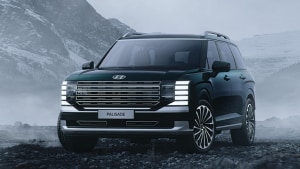2023 Hyundai Verna Turbo vs Volkswagen Virtus GT comparison review
Why would you still want a sedan? The case for this most traditional of body styles seems to be losing steam with every new SUV you see, despite the mild resurgence we've seen in the last year or so here. That's except for one scenario. When performance and driving character are high on your list of priorities.
Now Volkswagen has been your go-to brand to fulfil this need for the longest time, especially if you've wanted an engaging car that won't break the bank or asks you for any real compromises. The Volkswagen Virtus GT is the latest in the line of this but Hyundai has had something to say about this lately. Especially with the new Hyundai Verna turbo.
2023 Hyundai Verna Turbo vs Volkswagen Virtus GT: Dimensions, styling
The two sedans here may be aimed at the same audience, but the first impression they make on you when you see them is quite different. There's not much in the dimensions, the Volkswagen Virtus GT is 26 mm longer and 32mm taller while the Verna is 13mm wider.
The Virtus is the one that seems like the larger car. It's got a more traditional stance to it with simpler shapes and a more restrained design. This is far from a disadvantage, there's just the right mix of gravity and sportiness you want from a car such as this. The simple but well-detailed blacked-out headlamps and the usual horizontal Volkswagen grille work quite well with the slightly un-VW-like bumpers. They are quite attention-grabbing with the large black fascia and oversized foglamp clusters.

The Verna's 165mm of ground clearance against the Virtus's 179mm helps give it that squat, flat stance that looks so good with sedans. But it's the styling that will arrest you, one way or another. Like most new Hyundais, this Verna too throws out the design playbook. The nose is noticeably lower than the rest of the car which takes some getting used to. But the full-width LED lightbar and the discreet headlamp cluster within that full-face grille bring back some of the presence you might miss by skipping on an SUV. The grille is quite busy but cohesive with the clawed patterns and the ridges on either side. There are no fog lamps which puts the Verna at a disadvantage to the Virtus.

The Verna's distinctiveness continues with the side profile. The low bonnet line is even more apparent here but further along, you have that same angular design theme with the sharp creases along the bonnet. The new Hyundai theme of a sharp bodyline in the doors with a deep indent below, seen on the Tucson too, makes an appearance here as does the bulged rear haunches marked with a sharp cut. The Virtus again is more straightforward with its mild contours and simple lines which continues with a more refined glass area and a small but useful rear quarter-glass. The Verna's ends more abruptly with a scaled decorative motif that isn't quite as functional.
A neat touch though is the winglets that attach from the rear windscreen to the boot. The Verna's already more raked roofline looks all more notchback-like with these although the Virtus itself is far from a simple three-box shape.

The rear of the Virtus is again a good mix of function and form, the large square boot lid has an indent that forms with the split taillamps. The lamps themselves are again well-detailed with their black casing and sleek LED strips. But this is also where the Verna's design comes together fully. The big lettering and full-width H-pattern lighting with the crystalline LEDs catch your eye but the slatted look of the halogen indicators also work well.

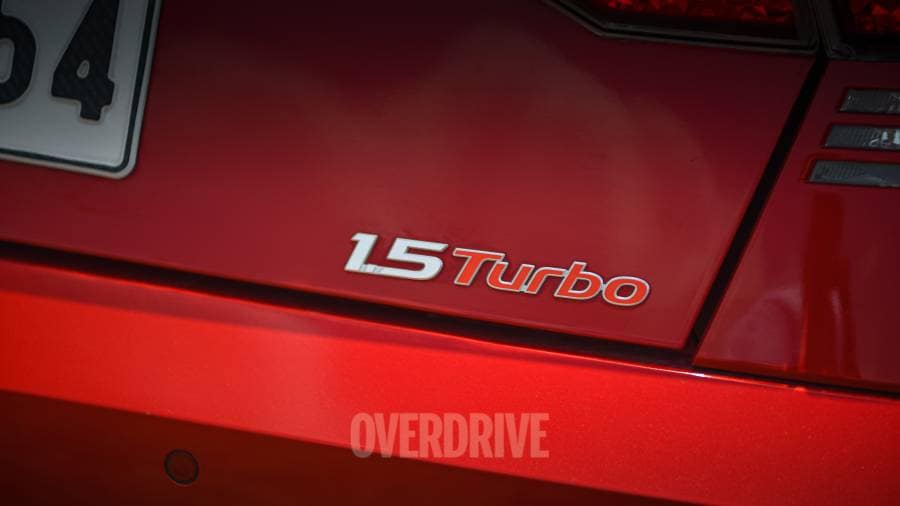
Both also do their bit to show themselves off to be the feistier versions of the range. The Virtus GT does it more prominently with the GT badges on the grille and fenders and the contrasting black on the roof, mirrors and spoiler. The Verna turbo is a touch more sedate about this, the small opening on the grille is an indicator but otherwise, you have a single turbo badge on the boot although you do get a blacked-out roof and wheels like the Virtus. With how much they differ in their design philosophies, it is clear that you will quite strongly prefer one over the other. But in our books, the Virtus GT seems to mix intent and sophistication a touch more cohesively, and it might be the one that ages better too.
2023 Hyundai Verna Turbo vs Volkswagen Virtus GT: Interiors, space, features, practicality
As off-beat as the Hyundai Verna turbo is from the outside, its interiors are thoughtful. But again right up there with the latest in automotive design. Its all-black theme for this turbo variant means that it doesn't quite have the same sense of space as the Virtus GT where Volkswagen has put to use a good mix of contrasting colours to brighten up the space.

As for the design itself, it's slim and light with a linear theme to it with the seamless layer for the air vents, highlighted by a red-contrasting strip in this turbo variant and underscored by a discreet sliver of ambient lighting. The central band is soft touch while you have the now quite typical floating two-part screen stack above this. The Virtus's dash is a more straightforward design but still looks quite classy. Its flat face with the red highlighting for this GT variant looks smart. The low-set air vents are simple but edgy, while the beige in the lower half again makes for a spacious feeling. Another nice touch is the way the centre stack angles towards the driver. There is ambient lighting but again limited to a small red band in front of the passenger.

You get capacitive touch panels in the lower half of the dash with both but with quite contrasting execution. You never really get used to the one in the Virtus with its small buttons and sliding panels for the climate functions. The Verna's on the other hand is an innovative switcable panel that swaps between climate and touchscreen functions. So you get large panels for the capacitive buttons that make them much easier to use and a convenient knob for the temperature as well as volume and track selection.
The touchscreen systems in both are fairly competent. The Verna is the usual feature-loaded Hyundai fare with built-in navigation, a wide range of connected tech functions and a PM 2.5 air filter. The Virtus doesn't have these but its big advantage is that you get wireless Android Auto/Apple Carplay, trip data and some apps. Both have quite intuitive menus and are easy to get used to. The Verna's is a touch larger at 10.25 inches against the Virtus GT's 10.1-inch screen. The Virtus goes further with a fully digital instrument cluster that feels much more premium to use with quite a high degree of customizability. The Verna has the usual Hyundai-Kia fare of a small colour MID flanked by LCDs which aren't quite as easy to read.
In terms of features, both get a single-pane sunroof, wireless charging, ventilated seats, eight-speaker audio(Bose branded in the Hyundai), leatherette upholstery with contrast stitching and auto headlamps. The Verna goes further with a partially powered driver's seat, heated seats and an electronic parking brake while the Virtus gets auto wipers.

As the driver, you are met with two great-feeling steering wheels. The Virtus's sportier shape is a bit easier to use but both feel very well textured with intuitively placed buttons. Weirdly the VW misses out on a call button that can get difficult. Both also get paddle shifters but the Verna's slightly larger ones fall to hand easier. You sit a bit lower in the Verna, in a more traditional sedan style and the seats offer a similar amount of thigh support in both. The Virtus is a nicer place to be in for the driver though with its better-judged cushioning and back support. The footwells feel a touch larger here too.
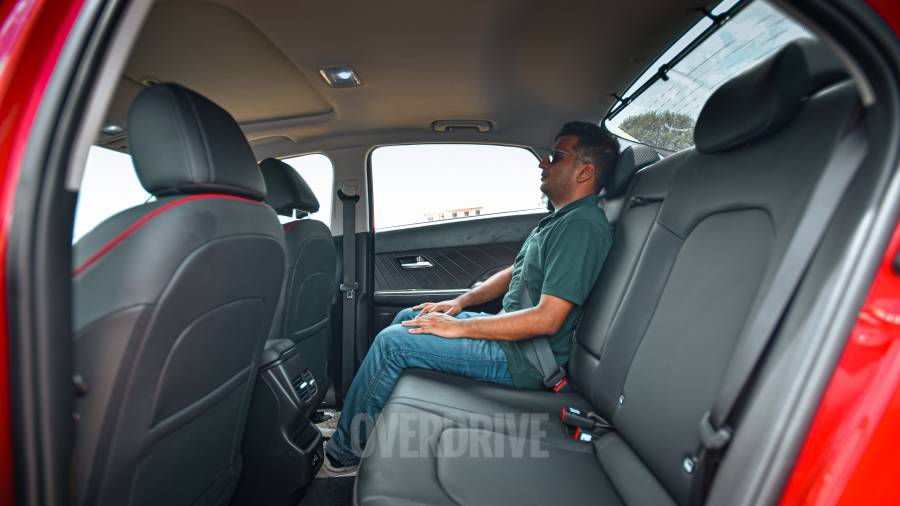
The Verna has a 19mm wheelbase advantage although in practice this seems much larger given there's noticeably more leg and knee room for rear passengers in the Verna. Yes, it feels a cosier space with the lower seating and darker colour themes but both have similarly wide benches. The cushioning in the Verna is a touch flatter, so while you have similar thigh support again you will be more comfortable in the Virtus over longer journeys with its more thoughtful contouring and cushioning, although this makes life a touch difficult if you are carrying a third passenger. The seatback is a touch more upright in the VW but not uncomfortable as such.
You get four USB chargers in both, with one of them being a Type-A charger in the Verna. The door pockets are much larger in the Hyundai too while you also get a cooled glovebox and usefully practicalitycentral cubbies.
2023 Hyundai Verna Turbo vs Volkswagen Virtus GT: Driving impressions, performance, real-world mileage
The Volkswagen Virtus GT and the Hyundai Verna turbo both get a 1.5-litre turbo-petrol paired with a seven-speed dual-clutch gearbox as seen here, while a six-speed manual is also available.
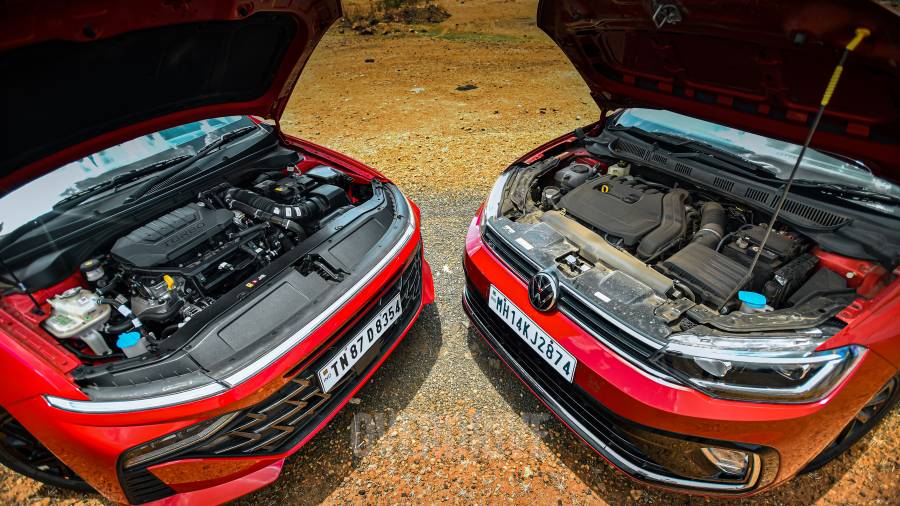
The Virtus's motor makes a healthy 150PS and 250 Nm but the new Hyundai-Kia turbo petrol that replaces the earlier 1.4-litre unit tops this with 160PS and 253 Nm. Driving the two cars together, it's clear soon enough that Hyundai isn't playing catch-up anymore as far as these turbo engines go. This new motor is more refined than the Volkswagen's. It's generally quieter at low revs and there are fewer vibrations filtering into the cabin. There's a more pleasing note to it as you rev it out too.

The Volkswagen seems to be a bit more adept just above idle where the turbo hasn't spooled up say while parking or in heavy traffic, but the Hyundai seems to get into its powerband earlier which makes driving in the city a tad bit easier. On paper, our rolling acceleration times suggest there's not much to choose between these two cars at middling speeds, but the Verna getting quicker as you near highway pace. They deliver performance as turbo-engines do with a strong mid-range surge that peters away as you get close to 6,000 rpm but the Verna makes for a smoother, and quicker, experience largely down to its more attentive gearbox tune and marginally freer revving character.

You get three drive modes in the Verna - Eco, Normal and Sport - while the Virtus GT has a sharper S gearbox mode. This does mean that the Verna has a wider breadth of ability since these modes change not just the steering heft and throttle sensitivity but also the gearbox's shift characteristics. The Virtus's default D gearbox mode seems about at par with the Verna's Eco, in that both seem to choose the highest possible gear here. But the Verna feels a touch more straightforward to drive with the gearbox being more responsive with its downshifts when you need more performance to overtake or catch up with traffic. The VW is more hesitant here and also sometimes over speed breakers and inclines.
The Volkswagen will hold gears for longer in the S mode and the Hyundai the same in the Sport mode but again functioning a touch more intuitively. The Verna is also more generous with engine braking so while downhill or driving fast around a twisty road, you find it shuffling down gears quite seamlessly, creating a generally more cohesive atmosphere. When using the paddles for some quite aggressive driving, the Volkswagen has an edge though. It'll give you downshifts well past 3,000 rpm which the Hyundai withholds for the sake of self-preservation. The Normal mode in the Verna finds a nice middle ground and is the one you will spend nearly all of your time in with its mix of alertness and quietness.
Of course, the Virtus GT's conservativeness here reaps some significant benefits in terms of fuel efficiency. Our real-world mileage test shows that the VW is notably more frugal both in city and highway driving conditions even with the Verna driven in its Eco mode. Both get start-stop but the system in the Volkswagen is more attentive, although the big differentiator is the cylinder-deactivation tech. That it's so seamlessly integrated into the drivetrain, choosing to shut off two cylinders in low engine load situations like while costing or at steady throttle, that you barely notice it work is a big positive.
Things even out somewhat between the two cars when you find that both feel a touch firmer than the average SUV over broken and uneven city streets. You feel these imperfections in the cabin, although they don't cause too much body movement in either car. That said, the Verna has a softer edge to it generally, which makes it more comfortable in these situations. This advantage shifts to the Virtus GT on a steady highway cruise. That great Volkswagen trait of feeling rock steady at these speeds is fully present in the Virtus. The suspension also comes into its own here, it keeps the car level over most undulations and there's an inherent confidence here that the Verna just falls short of.
To be fair, this Verna is a massive leap forward from the last generation, but there is still a tinge of skittishness that hasn't left it. It also can't quite handle those common long undulations on our highways as well as the VW, oscillating over these in a manner that belies its otherwise general surefootedness.
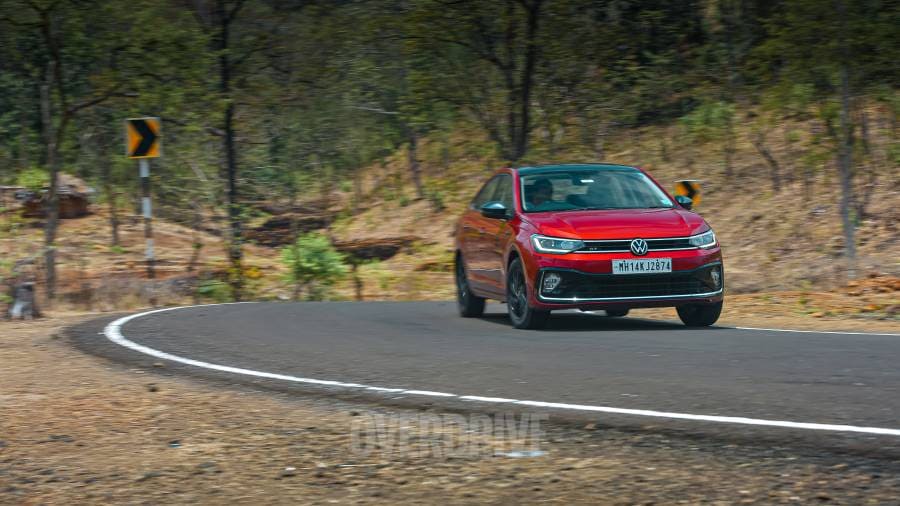

But show these cars a set of corners and the Hyundai again claws back ground. There's less roll here with it sitting closer to the ground, so the Verna leans more progressively into bends. While both run on 205/55 16-inch tyres, the ones in the Hyundai feel like they have more grip especially along long highway bends. With the Virtus, there's more roll to manage which has you slowing down a touch more. That said, the steering may be quite a bit lighter in the Volkswagen but still feels more precise and linear. So while there's more heft in the Verna's wheel, you never quite have the same sense of control, especially while threading through tight spaces. As an added benefit, the Virtus GT is just a bit less cumbersome to manoeuvre in traffic.
2023 Hyundai Verna Turbo vs Volkswagen Virtus GT: Safety, ADAS
The Volkswagen Virtus is the highest rated car in India as per Global NCAP's safety tests. This is largely down to its robust MQB-A0-IN architecture. Of course, you have a good list of safety equipment like TPMS, ESC, hill-start as well as six airbags. The Verna hasn't been crash tested yet and gives you all of these features. But its biggest advantage is a full suite of level 2 ADAS functions which also cover rearward collision avoidance. This adds to its slightly better braking figures, down to it being equipped with rear disc brakes.

2023 Hyundai Verna Turbo vs Volkswagen Virtus GT: Price, Verdict
The Volkswagen Virtus GT has so far ticked all the sporty sedan checkboxes. It looks just right and has an inviting and comfortable cabin with the performance and engagement you expect from a car with a sportier bent. The new Verna turbo builds on these credentials. It could have had better highway manners and more accommodating seats but other than this it looks striking, has a cutting-edge and feature-loaded cabin that happens to be more spacious and also performs just that bit better. To top that off, this top-spec variant is priced at Rs 20.50 lakh against Volkswagen's Rs 21.90 lakh.
2023 Hyundai Verna Turbo vs Volkswagen Virtus GT: Scorecard

2023 Hyundai Verna Turbo vs Volkswagen Virtus GT: Specifications, real-world mileage, performance

Also read,
Honda City e:HEV hybrid vs Volkswagen Virtus vs Skoda Slavia comparison review
Hyundai Verna first drive, review â" taking the fight back to the SUVs
2022 Volkswagen Virtus 1.5-litre GT review, first drive â" good news for enthusiasts?
â
Starts Rs 9.31 Lakhs
1493cc
Automatic
115
250
-NA-
Starts Rs 11.22 Lakhs
999cc
Manual
115
178
18.12 Kmpl
Starts Rs 10.9 Lakhs
1497cc
Manual
100
145
17.8 Kmpl
Starts Rs 19.5 Lakhs
1498cc
e-CVT
126
253
26.5 Kmpl
Starts Rs 10.69 Lakhs
1498cc
Automatic
150
250
18.41 Kmpl


